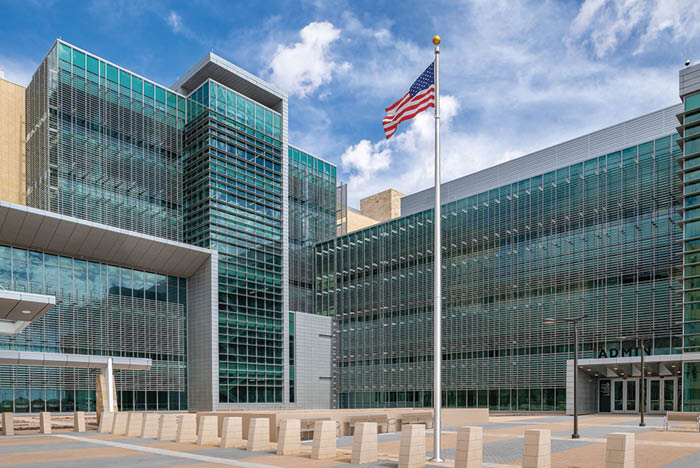New military hospital improves access to care in its region

The new William Beaumont Army Medical Center features glass and natural materials to reflect the area's topography.
Image courtesy of HDR
The new William Beaumont Army Medical Center (WBAMC) in El Paso, Texas, replaced a smaller and inconveniently located facility that was decades old. The patient population had grown considerably in that time, and the need for expanded access to health care grew with it. A modern medical campus that provided inpatient and outpatient care was more than overdue. It was crucial.
“The borderland region is officially recognized as a medically underserved area, and the addition of this facility brings a crucial capability to northeast El Paso,” says Col. Michael Oshiki, M.D., assistant deputy secretary of the army for health affairs at U.S. Army. “This is going to allow us to not only expand our ability to treat civilian emergency cases and help the El Paso community in treating those patients, it also increases our readiness to deploy around the world in support of military operations.”
The campus is organized by building function: inpatient, outpatient and administration/education. Design firm HDR developed a criteria checklist to address patient and staff safety, infection control, care coordination, technology integration and workplace efficiency to drive and improve patient outcomes.
“The commitment of our design team and partners was to attain and achieve the long-term goal of a world-class medical facility in support of our warriors and their families,” says Dan Friedman, senior project architect at HDR. “The William Beaumont Army Medical Center is a state-of-the-art medical complex designed as a sustainable, adaptable, efficient, patient-friendly and flexible facility to support the required health care services for active military personnel and their families.”
The 1.3-million-square-foot campus is comprised of a 135-bed hospital with 10 operating rooms and 30 specialty clinics, including an emergency department, and is designated as a Level II trauma center with Secretarial Designee status. It houses outpatient clinics, an administrative and education building with a graduate medical education program, a clinical investigation building with a vivarium, and a central utility plant. The campus is designed in compliance with National Institutes of Health guidelines and the Association for Assessment and Accreditation of Laboratory Animal Care accreditation.
The functionality and aesthetics of the new campus were driven by evidence-based design, a scientifically based methodology that utilizes data to measure the physical and psychological effects of the built environment on its occupants, then incorporates those findings into the design and construction process.
Interior and exterior finishes include native stone, colors, patterns and textures found in the culture, geography and topography of the region. Glass walls and large windows provide abundant natural light and views of surrounding gardens and natural landscapes, including the nearby Franklin Mountains.
On July 1, WBAMC conducted a dedication ceremony for the new facility, 100 years to the day that the distinguished, long-serving hospital that it replaced, the William Beaumont General Hospital — named for the father of gastric physiology — opened its doors in 1921. On July 11, WBAMC officially welcomed all staff members, patients and the community, and simultaneously stopped receiving patients in the legacy emergency room and began seeing them in the new one, with 20 inpatients safely transferred between the two facilities.
Lieut. Gen. Ronald Pace, Defense Health Agency director, acknowledged the impact that WBAMC would have on the members of the armed services and all those associated with them.
“The money, the mortar, the medics who work here are all representatives of a promise that this country makes to our soldiers, sailors, airmen, Marines, our guardians and partners, and all of their families,” he says.
Oshiki recognized the significance of the new facility to the region.
“The opening of what is the newest, most technologically advanced medical center in the Department of Defense is the culmination of years of work,” he says. “It is significant not just for William Beaumont and Fort Bliss, but for our greater El Paso community.”




